Unit 4 Body language Using language课件(49张PPT)
文档属性
| 名称 | Unit 4 Body language Using language课件(49张PPT) | 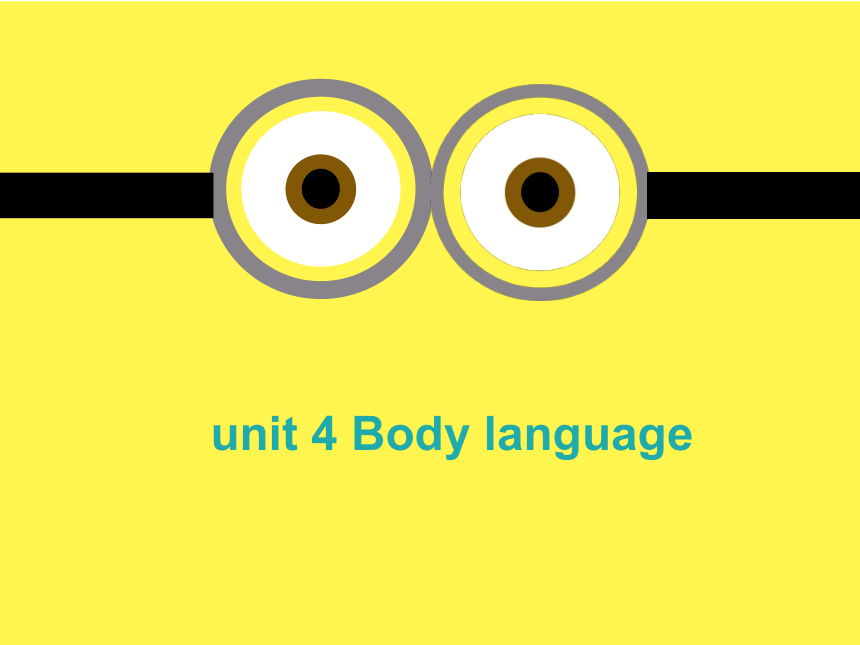 | |
| 格式 | zip | ||
| 文件大小 | 4.3MB | ||
| 资源类型 | 教案 | ||
| 版本资源 | 人教版(新课程标准) | ||
| 科目 | 英语 | ||
| 更新时间 | 2019-10-25 22:39:21 | ||
图片预览


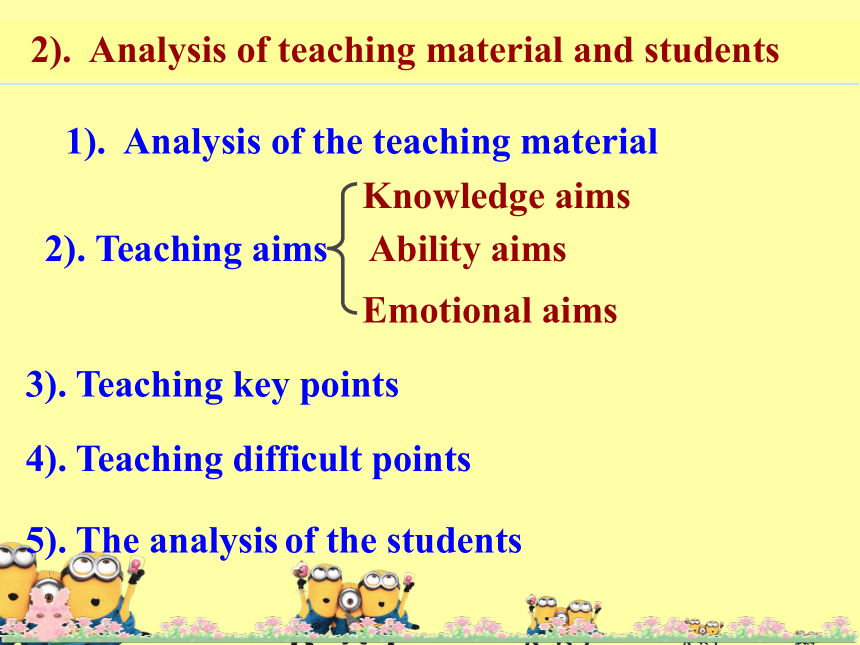
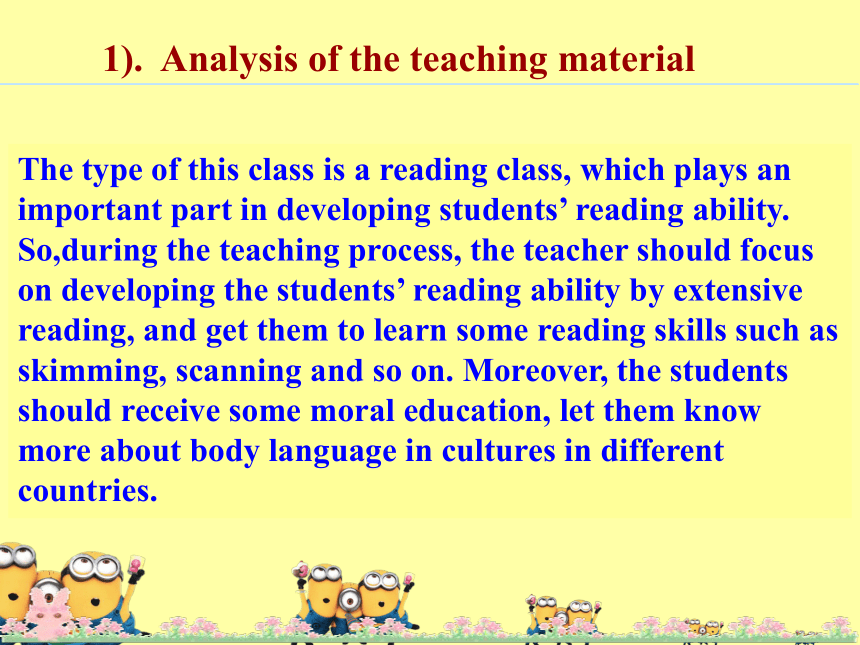
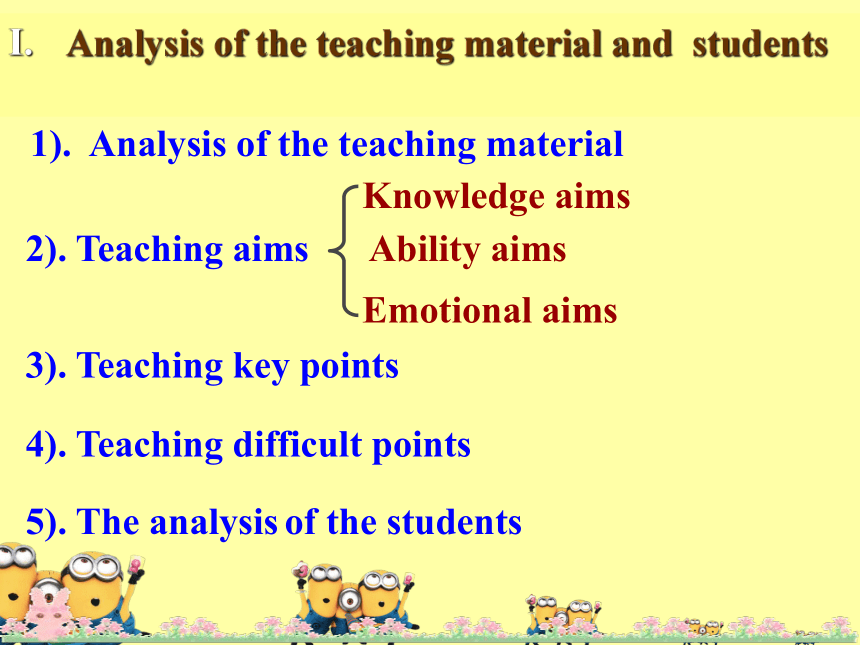
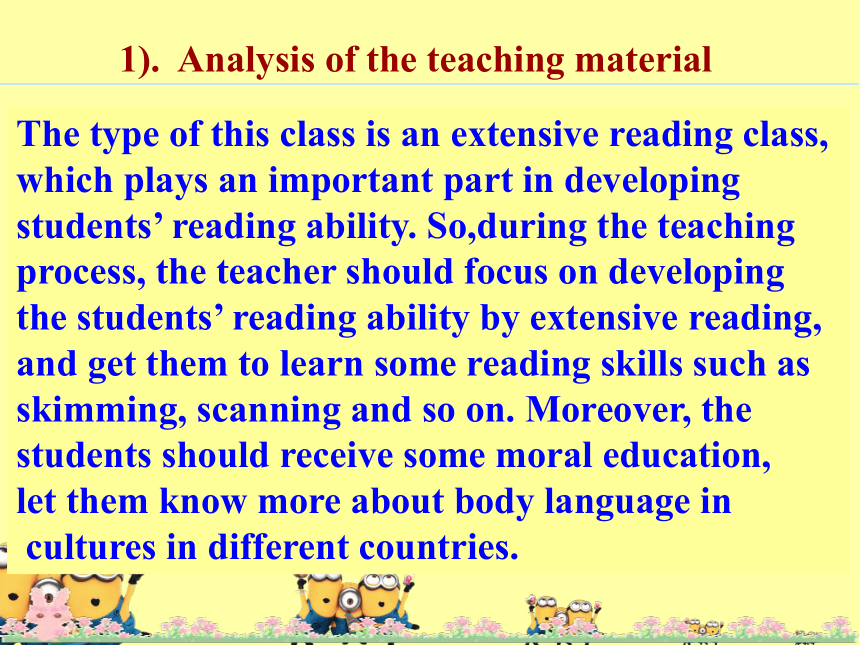

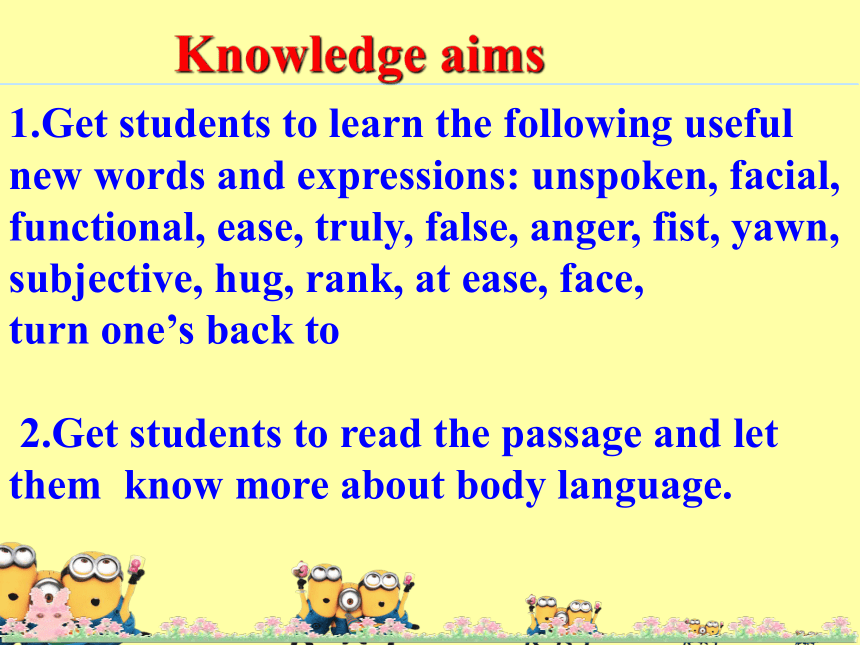
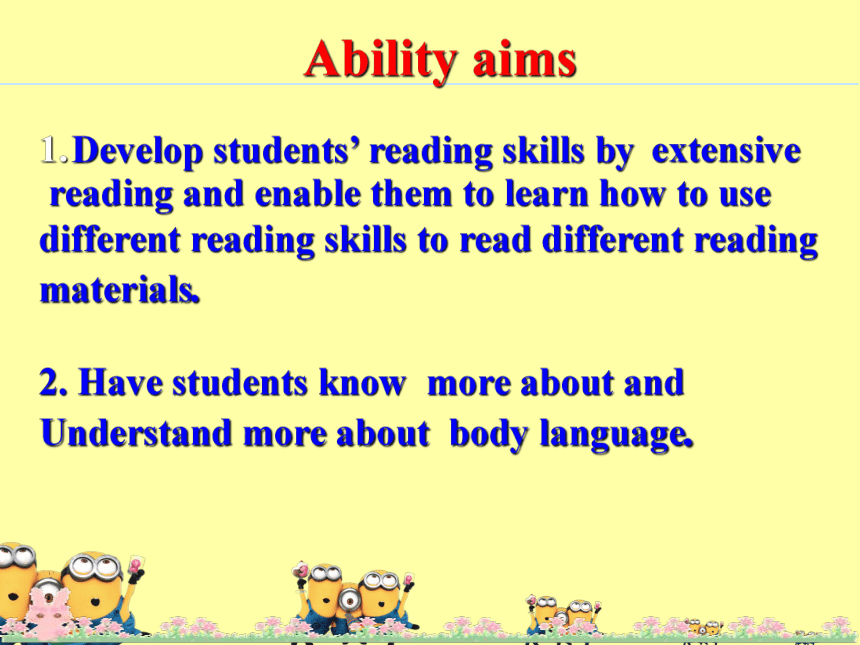
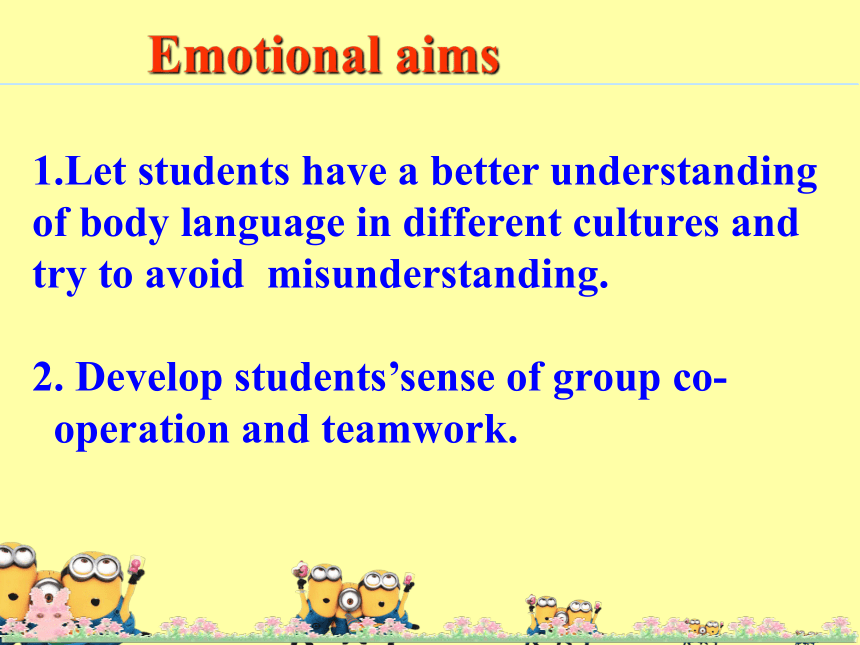

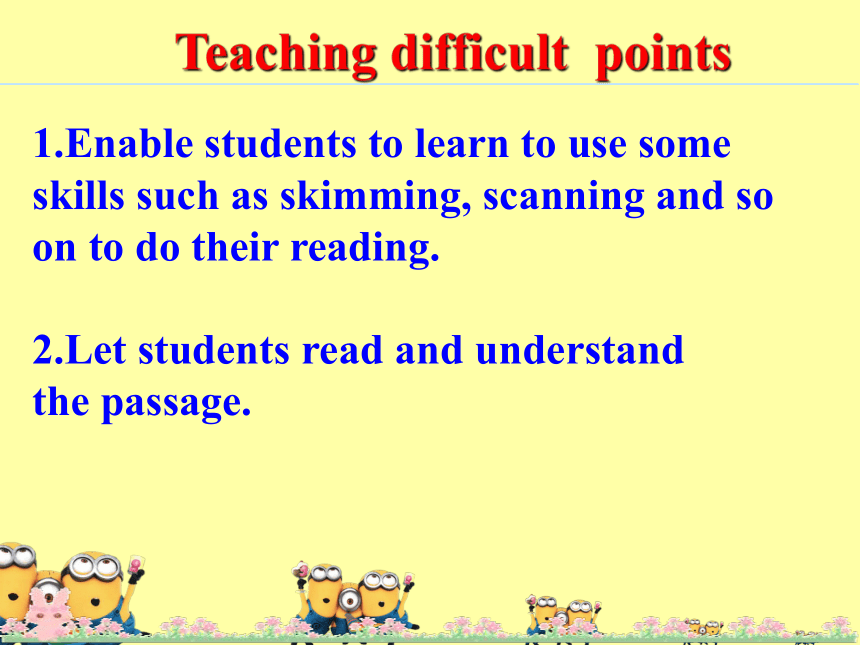
文档简介
(共49张PPT)
unit 4 Body language
I. Analysis of teaching material and students
II. Teaching theories
III. Teaching methods, studying ways and aids
IV. Teaching procedures
V. Blackboard design
2). Analysis of teaching material and students
Knowledge aims
Ability aims
3). Teaching key points
4). Teaching difficult points
1). Analysis of the teaching material
5). The analysis of the students
2). Teaching aims
Emotional aims
1). Analysis of the teaching material
The type of this class is a reading class, which plays an important part in developing students’ reading ability. So,during the teaching process, the teacher should focus on developing the students’ reading ability by extensive reading, and get them to learn some reading skills such as skimming, scanning and so on. Moreover, the students should receive some moral education, let them know more about body language in cultures in different countries.
Analysis of the teaching material and students
Knowledge aims
Ability aims
3). Teaching key points
4). Teaching difficult points
1). Analysis of the teaching material
5). The analysis of the students
2). Teaching aims
Emotional aims
1). Analysis of the teaching material
The type of this class is an extensive reading class,
which plays an important part in developing
students’ reading ability. So,during the teaching
process, the teacher should focus on developing
the students’ reading ability by extensive reading,
and get them to learn some reading skills such as
skimming, scanning and so on. Moreover, the
students should receive some moral education,
let them know more about body language in
cultures in different countries.
2). Analysis of the students
As to the students of our class ,most of them
are poor in English, they show little interest
in learning English, they are lack of vocabulary
and confidence. So, during the teaching process,
the teacher should focus on how to arouse their
interest in English, in addition, the teacher should
teach them the proper way to learn English and
encourage them to learn English well.
Knowledge aims
1.Get students to learn the following useful
new words and expressions: unspoken, facial,
functional, ease, truly, false, anger, fist, yawn,
subjective, hug, rank, at ease, face,
turn one’s back to
2.Get students to read the passage and let
them know more about body language.
Ability aims
Develop students’ reading skills by extensive
reading and enable them to learn how to use
different reading skills to read different reading
materials.
2. Have students know more about and
Understand more about body language.
Emotional aims
1.Let students have a better understanding
of body language in different cultures and
try to avoid misunderstanding.
2. Develop students’sense of group co-
operation and teamwork.
Teaching key points
1. Develop students’ reading skills by extensive reading.
2. Have students master the important new words and expressions in this part.
3.Let students read and understand the passage “Communication:No problem?”.
Teaching difficult points
1.Enable students to learn to use some skills such as skimming, scanning and so on to do their reading.
2.Let students read and understand
the passage.
III. Teaching methods, studying ways and aids
1)Task-based teaching approach
2)Scanning, skimming
3)Question-and-answer activity teaching
method
4)Pair work and individual work method
Teaching aids
1.A multi-media computer
2.Other normal teaching tools
IV. Teaching procedures and ways
Part 1(Pre class Exploration)
Part 2(Teaching Procedures)
Part3 (Post-class Extension)
(Pre-class Exploration):
Let students search for more information
about body language which shows different
meanings in different cultures and countries.
Aims:Although the students have known something about body language they may not aware that there may be differences. At the same time,the students can improve their self-learning ability by doing so。
Teaching Procedures
Step 1. Lead- in
Step 2. Pre- reading
Step 3. While-reading
1).Fast reading
2).Detail reading
Step 4. Post-reading
Step 5. Consolidation
Step 6. Homework.
Step 1 Lead-in 3mins
1.Usually what gestures we will do ?
2.What’s the meaning of the following
gestures?
3.What’s the meaning of the following face expressions?
Three activities:
I am tired.
I am full.
I am hungry.
press palms/rest
your head on it/
eyes closed
move hand
in circle
pat stomach
Usually what gestures we will do ?
Well-done
Ok
stop
quiet
Gestures
victory!
stop
Shake hands
Happy
A review of body language
Facial Expression
happy
sad
interested
angry
surprised
curious
Surprised/
astonished
shy
happy
You’re great!
Come and join us!
I’m listening carefully!
Body movements
What are they trying to tell us?
Please stop!
Nice to meet you!
I’m sorry!
Give me a little time!
I’m thinking!
It’s important.
I give up.
OK!
Body Language is a set of __________, _______________ and ____________ . People use to make themselves understood.
gestures
body movements
facial expressions
speaking
ringing
writing
typing
Spoken
language
Written
language
Body
language
Ways of communicating
gestures
facial expression
body movements
Pre-reading
Step 2(5mins)
Discussion :
1.What is the function of body language?
2. What do think the role of body language in our daily life?
3. Are all the body language the same in the world? What do you know about them?
Step 3 While-reading
Fast-reading
I went to the Airport to meet the international students.
People from different countries have different body language.
Summary of body language.
Part 1
(Para. 1)
Part 2 (Para. 2-4 )
Part 3
(Para. 5 )
A
B
C
Step 2: Reading Comprehension I
What is the main idea of the text?
A. There are different customs in different
countries.
B. Foreigners should follow the customs of the
country where they are visiting.
C. People have different body language in
different cultures.
D. The importance of knowing customs.
Read the passage carefully and finish the following reading tasks.
Detail-reading
Find out the two cultural mistakes in Para2
Tony Garcia
Julia Smith
The first mistake
(Colombia )
(Britain)
He approached Julia, ________ _____ _________and _______ her on the ________.
She ______ ________ appearing _________ and put up her hands, as if ___ _______.
shoulder
touched
her
kissed
cheek
stepped back
surprised
in defence
The second mistake
Akira Nagata
(Japan)
George Cook
(Canada)
He ________ his hand ________ to the Japanese student.
He ________ so his nose ________George’s _______ ______.
bowed
touched
moving
hand
reached
out
1.How do men from Muslim countries greet others ?
2. Is the author male or female? How do you know?
3. How did Tony and Dave greet each other?
Para3:
They shook hands and then kissed each other twice on each cheek, and this is the French custom when adults meet people they know.
To men:
To women:
stand close, and shake hands
nod
Male.Because Ahmed Aziz only shakes hands with men.
People in the country / area Ways to greet each other
English people
People from Spain, Italy and South American countries
Most people around the world
_________ others closely and are more likely to __________.
Do not stand _________ to others or touch ________ when they meet.
bow
shake hands
Fill in the table according to Para4:
very close
strangers
Approach
touch them
Japanese
Post-reading
Step 5 10mins
Step 6 Consolidation 5mins
1.Finish some words and expressions exercises
2.Finish the summary of the passage.
____ language is _______ from culture to ______. Not all ________of a culture ______ in the _____ way. In general, _______ inter-
national customs can certainly help _____ difficulties in the cultural communication.
Body
different
culture
members
behave
same
studying
avoid
Summary
Discussion
How can we know other’s feelings, even if they do not speak to us?
Why should we be careful of our own body language ?
if you want to study abroad or live abroad,there may be cultural shock(文化冲击),how do you deal with it?
cultural shock?
Enjoy a video
Step 7. Homework
1.Surf on the Internet, try to know
more about body language and tell
your classmates.
2.watch a movie with no sound,
try to guess the body language
V. Blackboard design (板书设计)
Part 1 I went to the Airport to meet the international students.
Part 2 People from different countries have different body language.
Part3 Differences in body language
spoken language
written language
body language
Unit 4 Body language
reading
The Ingredients Of Your Life
This is a glass of water, tasteless, right? However if you add sugar, it will taste sweet, but if you add vinegar, it will become bitter. The same is true with our life the flavor is created by our choices.
If kindness is added to a strange you will have a friend; but if hostility is added, you will have an enemy. If love is added to a pile of red bricks you will have a home, but if hatred is add to those bricks , you will have an concentration camp.
So my dear friends, never complain that life is boring and the world is disappointing. If don’t like the taste of your life, change the ingredients.
So my dear friends, never complain that life is boring and the world is disappointing. If don’t like the taste of your life, change the ingredients.
When I was a middle school student, I weighed more than 60 kilograms which caused significant embarrassment and frustration in my life. Like always failing my P.E examinations, like always being laughed at by girls, like being terrified to speak in public. It was my grandmother’s encouragement that revived from my passive attitude to become confident in myself. She said “ My dear, if you can’t change you figure, why not treat it as your own style. So I began to cautiously employ the new way of thinking. By choosing to change my outlook on life, I developed the confidence to make a difference and finally I found a totally new world.
So my dear friend, if faith, hope, love, endurance are added to your life, you will find the confidence to conquer your limitation and embrace new challenges. And hopefully with my speech included, you will have a fantastic speech contest.
unit 4 Body language
I. Analysis of teaching material and students
II. Teaching theories
III. Teaching methods, studying ways and aids
IV. Teaching procedures
V. Blackboard design
2). Analysis of teaching material and students
Knowledge aims
Ability aims
3). Teaching key points
4). Teaching difficult points
1). Analysis of the teaching material
5). The analysis of the students
2). Teaching aims
Emotional aims
1). Analysis of the teaching material
The type of this class is a reading class, which plays an important part in developing students’ reading ability. So,during the teaching process, the teacher should focus on developing the students’ reading ability by extensive reading, and get them to learn some reading skills such as skimming, scanning and so on. Moreover, the students should receive some moral education, let them know more about body language in cultures in different countries.
Analysis of the teaching material and students
Knowledge aims
Ability aims
3). Teaching key points
4). Teaching difficult points
1). Analysis of the teaching material
5). The analysis of the students
2). Teaching aims
Emotional aims
1). Analysis of the teaching material
The type of this class is an extensive reading class,
which plays an important part in developing
students’ reading ability. So,during the teaching
process, the teacher should focus on developing
the students’ reading ability by extensive reading,
and get them to learn some reading skills such as
skimming, scanning and so on. Moreover, the
students should receive some moral education,
let them know more about body language in
cultures in different countries.
2). Analysis of the students
As to the students of our class ,most of them
are poor in English, they show little interest
in learning English, they are lack of vocabulary
and confidence. So, during the teaching process,
the teacher should focus on how to arouse their
interest in English, in addition, the teacher should
teach them the proper way to learn English and
encourage them to learn English well.
Knowledge aims
1.Get students to learn the following useful
new words and expressions: unspoken, facial,
functional, ease, truly, false, anger, fist, yawn,
subjective, hug, rank, at ease, face,
turn one’s back to
2.Get students to read the passage and let
them know more about body language.
Ability aims
Develop students’ reading skills by extensive
reading and enable them to learn how to use
different reading skills to read different reading
materials.
2. Have students know more about and
Understand more about body language.
Emotional aims
1.Let students have a better understanding
of body language in different cultures and
try to avoid misunderstanding.
2. Develop students’sense of group co-
operation and teamwork.
Teaching key points
1. Develop students’ reading skills by extensive reading.
2. Have students master the important new words and expressions in this part.
3.Let students read and understand the passage “Communication:No problem?”.
Teaching difficult points
1.Enable students to learn to use some skills such as skimming, scanning and so on to do their reading.
2.Let students read and understand
the passage.
III. Teaching methods, studying ways and aids
1)Task-based teaching approach
2)Scanning, skimming
3)Question-and-answer activity teaching
method
4)Pair work and individual work method
Teaching aids
1.A multi-media computer
2.Other normal teaching tools
IV. Teaching procedures and ways
Part 1(Pre class Exploration)
Part 2(Teaching Procedures)
Part3 (Post-class Extension)
(Pre-class Exploration):
Let students search for more information
about body language which shows different
meanings in different cultures and countries.
Aims:Although the students have known something about body language they may not aware that there may be differences. At the same time,the students can improve their self-learning ability by doing so。
Teaching Procedures
Step 1. Lead- in
Step 2. Pre- reading
Step 3. While-reading
1).Fast reading
2).Detail reading
Step 4. Post-reading
Step 5. Consolidation
Step 6. Homework.
Step 1 Lead-in 3mins
1.Usually what gestures we will do ?
2.What’s the meaning of the following
gestures?
3.What’s the meaning of the following face expressions?
Three activities:
I am tired.
I am full.
I am hungry.
press palms/rest
your head on it/
eyes closed
move hand
in circle
pat stomach
Usually what gestures we will do ?
Well-done
Ok
stop
quiet
Gestures
victory!
stop
Shake hands
Happy
A review of body language
Facial Expression
happy
sad
interested
angry
surprised
curious
Surprised/
astonished
shy
happy
You’re great!
Come and join us!
I’m listening carefully!
Body movements
What are they trying to tell us?
Please stop!
Nice to meet you!
I’m sorry!
Give me a little time!
I’m thinking!
It’s important.
I give up.
OK!
Body Language is a set of __________, _______________ and ____________ . People use to make themselves understood.
gestures
body movements
facial expressions
speaking
ringing
writing
typing
Spoken
language
Written
language
Body
language
Ways of communicating
gestures
facial expression
body movements
Pre-reading
Step 2(5mins)
Discussion :
1.What is the function of body language?
2. What do think the role of body language in our daily life?
3. Are all the body language the same in the world? What do you know about them?
Step 3 While-reading
Fast-reading
I went to the Airport to meet the international students.
People from different countries have different body language.
Summary of body language.
Part 1
(Para. 1)
Part 2 (Para. 2-4 )
Part 3
(Para. 5 )
A
B
C
Step 2: Reading Comprehension I
What is the main idea of the text?
A. There are different customs in different
countries.
B. Foreigners should follow the customs of the
country where they are visiting.
C. People have different body language in
different cultures.
D. The importance of knowing customs.
Read the passage carefully and finish the following reading tasks.
Detail-reading
Find out the two cultural mistakes in Para2
Tony Garcia
Julia Smith
The first mistake
(Colombia )
(Britain)
He approached Julia, ________ _____ _________and _______ her on the ________.
She ______ ________ appearing _________ and put up her hands, as if ___ _______.
shoulder
touched
her
kissed
cheek
stepped back
surprised
in defence
The second mistake
Akira Nagata
(Japan)
George Cook
(Canada)
He ________ his hand ________ to the Japanese student.
He ________ so his nose ________George’s _______ ______.
bowed
touched
moving
hand
reached
out
1.How do men from Muslim countries greet others ?
2. Is the author male or female? How do you know?
3. How did Tony and Dave greet each other?
Para3:
They shook hands and then kissed each other twice on each cheek, and this is the French custom when adults meet people they know.
To men:
To women:
stand close, and shake hands
nod
Male.Because Ahmed Aziz only shakes hands with men.
People in the country / area Ways to greet each other
English people
People from Spain, Italy and South American countries
Most people around the world
_________ others closely and are more likely to __________.
Do not stand _________ to others or touch ________ when they meet.
bow
shake hands
Fill in the table according to Para4:
very close
strangers
Approach
touch them
Japanese
Post-reading
Step 5 10mins
Step 6 Consolidation 5mins
1.Finish some words and expressions exercises
2.Finish the summary of the passage.
____ language is _______ from culture to ______. Not all ________of a culture ______ in the _____ way. In general, _______ inter-
national customs can certainly help _____ difficulties in the cultural communication.
Body
different
culture
members
behave
same
studying
avoid
Summary
Discussion
How can we know other’s feelings, even if they do not speak to us?
Why should we be careful of our own body language ?
if you want to study abroad or live abroad,there may be cultural shock(文化冲击),how do you deal with it?
cultural shock?
Enjoy a video
Step 7. Homework
1.Surf on the Internet, try to know
more about body language and tell
your classmates.
2.watch a movie with no sound,
try to guess the body language
V. Blackboard design (板书设计)
Part 1 I went to the Airport to meet the international students.
Part 2 People from different countries have different body language.
Part3 Differences in body language
spoken language
written language
body language
Unit 4 Body language
reading
The Ingredients Of Your Life
This is a glass of water, tasteless, right? However if you add sugar, it will taste sweet, but if you add vinegar, it will become bitter. The same is true with our life the flavor is created by our choices.
If kindness is added to a strange you will have a friend; but if hostility is added, you will have an enemy. If love is added to a pile of red bricks you will have a home, but if hatred is add to those bricks , you will have an concentration camp.
So my dear friends, never complain that life is boring and the world is disappointing. If don’t like the taste of your life, change the ingredients.
So my dear friends, never complain that life is boring and the world is disappointing. If don’t like the taste of your life, change the ingredients.
When I was a middle school student, I weighed more than 60 kilograms which caused significant embarrassment and frustration in my life. Like always failing my P.E examinations, like always being laughed at by girls, like being terrified to speak in public. It was my grandmother’s encouragement that revived from my passive attitude to become confident in myself. She said “ My dear, if you can’t change you figure, why not treat it as your own style. So I began to cautiously employ the new way of thinking. By choosing to change my outlook on life, I developed the confidence to make a difference and finally I found a totally new world.
So my dear friend, if faith, hope, love, endurance are added to your life, you will find the confidence to conquer your limitation and embrace new challenges. And hopefully with my speech included, you will have a fantastic speech contest.
同课章节目录
